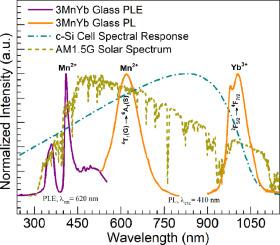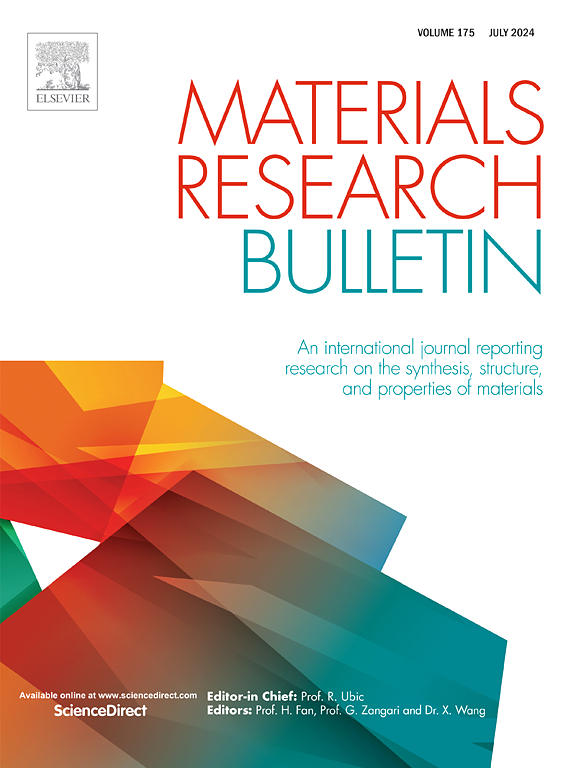Yb3+-activated phosphate glasses melted with MnCO3 for solar spectral conversion
IF 5.3
3区 材料科学
Q2 MATERIALS SCIENCE, MULTIDISCIPLINARY
引用次数: 0
Abstract
This paper reports on the physical and optical properties of phosphate glasses containing red-emitting Mn2+ and near-infrared (NIR)-emitting Yb3+ ions of interest for solar spectral conversion. The glasses were prepared by melting with 50P2O5-(48 – x)BaCO3–2Yb2O3-xMnCO3 (x = 0, 1, 2, 3, 4 mol%) formulas, and characterized by X-ray diffraction (XRD), Fourier transform-infrared (FT-IR) spectroscopy, differential scanning calorimetry (DSC), UV–Vis-NIR spectrophotometry, and photoluminescence (PL) spectroscopy. The glasses were X-ray amorphous with the various characteristic features of phosphate glasses being evident in the FT-IR spectra. The thermal properties of the co-doped glasses assessed by DSC appeared similar despite the variation in manganese content. The optical absorption spectra supported the occurrence of Mn2+ ions while Mn3+ was detected at high MnCO3 content. The NIR absorption due to Yb3+ ions was nonetheless consistent with the fixed Yb2O3 content. The PL evaluation showed that sensitized Yb3+PL was attained under Mn2+excitation at 410 nm where the NIR emission increased with MnCO3 content in connection with Mn2+→ Yb3+ energy transfer. However, the NIR emission output realized with 4 mol% MnCO3 was just marginally higher than the obtained with 3 mol% MnCO3. On the other hand, the red Mn2+emission was highest for 3 mol% MnCO3. Thus, considering the optimized red and NIR emissions while minimizing absorption by Mn3+, the Yb-containing glass melted with 3 mol% MnCO3 was put in perspective with the concept of solar spectral conversion.

熔融 MnCO3 的 Yb3+ 激活磷酸盐玻璃用于太阳能光谱转换
本文报告了磷酸盐玻璃的物理和光学特性,这些玻璃含有用于太阳能光谱转换的红色发光 Mn2+ 离子和近红外(NIR)发光 Yb3+ 离子。这些玻璃是通过熔融 50P2O5-(48-x)BaCO3-2Yb2O3-xMnCO3(x = 0、1、2、3、4 摩尔%)配方制备的,并通过 X 射线衍射 (XRD)、傅立叶变换红外光谱 (FT-IR)、差示扫描量热法 (DSC)、紫外-可见-近红外分光光度法和光致发光 (PL) 光谱进行表征。玻璃呈 X 射线无定形,傅立叶变换红外光谱显示出磷酸盐玻璃的各种特征。尽管锰的含量不同,但通过 DSC 评估的共掺玻璃的热性能却相似。光学吸收光谱表明存在 Mn2+ 离子,而在 MnCO3 含量较高时则检测到 Mn3+。然而,Yb3+ 离子的近红外吸收与固定的 Yb2O3 含量一致。聚光评估显示,在 410 纳米波长的 Mn2+激发下,实现了敏化 Yb3+聚光,近红外发射随 MnCO3 含量的增加而增加,这与 Mn2+→Yb3+ 的能量转移有关。然而,4 摩尔 MnCO3 的近红外发射输出仅略高于 3 摩尔 MnCO3 的近红外发射输出。另一方面,3 摩尔% MnCO3 的红色 Mn2+ 发射率最高。因此,考虑到在优化红色和近红外发射的同时尽量减少 Mn3+ 的吸收,使用 3 摩尔% MnCO3 熔化的含镱玻璃符合太阳光谱转换的概念。
本文章由计算机程序翻译,如有差异,请以英文原文为准。
求助全文
约1分钟内获得全文
求助全文
来源期刊

Materials Research Bulletin
工程技术-材料科学:综合
CiteScore
9.80
自引率
5.60%
发文量
372
审稿时长
42 days
期刊介绍:
Materials Research Bulletin is an international journal reporting high-impact research on processing-structure-property relationships in functional materials and nanomaterials with interesting electronic, magnetic, optical, thermal, mechanical or catalytic properties. Papers purely on thermodynamics or theoretical calculations (e.g., density functional theory) do not fall within the scope of the journal unless they also demonstrate a clear link to physical properties. Topics covered include functional materials (e.g., dielectrics, pyroelectrics, piezoelectrics, ferroelectrics, relaxors, thermoelectrics, etc.); electrochemistry and solid-state ionics (e.g., photovoltaics, batteries, sensors, and fuel cells); nanomaterials, graphene, and nanocomposites; luminescence and photocatalysis; crystal-structure and defect-structure analysis; novel electronics; non-crystalline solids; flexible electronics; protein-material interactions; and polymeric ion-exchange membranes.
 求助内容:
求助内容: 应助结果提醒方式:
应助结果提醒方式:


